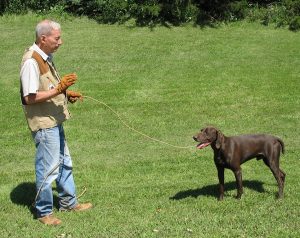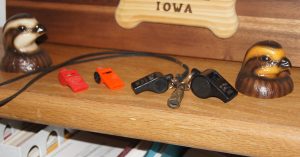What’s the Best Way to Train Your Pointing Dog?
POINTING DOG POINTERS March 2018
By Bob and Jody Iler
When it comes to the training methods that are used today to develop a pointing dog – we’ve come a long way, baby! With many good videos, books, and seminars offered on the subject, there are diverse options for the average dog owner to choose from. But there is really no one canned method guaranteed to do the job and do it well. Plain and simple – some methods are better than others.
So which one is right for you? If you don’t have a lot of experience in training a pointing dog, how do you know what method to choose? We aren’t going to endorse one method over another in this article; rather, we’ve put together a list to consider as you figure out what’s best for you and your dog.
Read Your Dog First!
Learning to read your pup is the first element of successful dog training. Is he soft, hard-headed, or somewhere in between? Showing the pup what you want and using repetition, fairness, and firmness is important for all pups; but extra time and gentle handling are often crucial with soft or shy types. Knowledgeable trainers adjust their program to the particular dog’s temperament. Often this can mean revamping a method as the training unfolds and development issues pop up.
Read Yourself!
What kind of a trainer will you be? Are you patient or quick to lose your temper? Can you take your time and move along at your pup’s pace? Are you willing to do what works for you and your pup and not what someone else tells you to do? Are you willing to check with proven professional trainers if you have a problem you don’t know how to fix?
Don’t Push Puppies!
Whatever training program you decide to go with, you don’t want to rush your pup through it. Pups are like kids and develop at their own pace within a program geared to their strengths and weaknesses. Pushing your pup to do things she’s not ready for will set you back in your training program. Too much pressure and pushing can ruin promising pups.
Less is Better!
Whatever area of training you’re working on, keep in mind that less is better. One solid point, one shot to down a bird, one good retrieve – one pup learning the ropes in the field with one handler. Keeping things simple and stopping after one successful session will do more to instill enthusiasm in your pup than repeated drills that result in mistakes and diminished fun.
Smaller Birds First!
If you are lucky enough to have your own acreage to keep some birds for dog training, you’ll want to focus on smaller birds for initial training, such as pigeons and quail. Some pups don’t turn on to pigeons, so gamebirds are necessary. And with young pups you’ll always want to start out with gentle introduction to small birds like quail before moving on to larger gamebirds. If you don’t have a place to keep birds, you can check with game farms or preserves and bird dog clubs for available quail for training use. In the early stages, it’s important to get your pup out on birds that you know are there, so the pup will be successful in finding them.
Birds Before Guns!
Pointing dogs should learn to love hunting, scenting, and finding birds first – even chasing them early on – before adding gun development to the program. They should be focused on birds to the exclusion of all else as gunfire is introduced in gradual, progressive stages, always watching for the pup’s reaction. Gun work should never be a “stand alone” project, such as taking a pup to the gun range to see how he reacts, or exposing him to random gunfire to “de-sensitize” him. More problems result in this area of training than any other, and sometimes simply can’t be fixed.
Easy Does It With Training Aids
The e-collars of yesteryear had giant transmitters that had only one level – high! Today, we have collars with 20-plus levels, vibration options, and tracking features. There are excellent training aids available now to help us develop our pointing dogs. We have electronic bird releasers, metal traps, dog vests and foot booties, special collars or roading harnesses, and on and on. Catalogs and online sites offer an extensive assortment of training aids.
Much of this equipment comes with the caveat that you should know, or be sure to learn, how to properly use these training aids. When, where, and how to use bird releasers and at what stage in a pup’s training are key. When and how to use an e-collar is even more crucial. We feel that the e-collar generally has no place in the early development of a bird dog, especially in the hands of an amateur. We’d suggest starting out with a 20-foot checkcord, a good whistle, and a slip collar (used only for training) with a six-foot lead for yard work. With these basic tools, you can teach your pup to heel, whoa, come when called, and to handle in the field. This is the groundwork foundation on which all other training depends.
Don’t Set a Timetable!
Realistically speaking, training your dog does not have a start and finish time; the training is always ongoing. Dog work can become sloppy and deteriorate if we don’t continue to work regularly with our pups, always showing them how we want them to behave. With a finished dog that is steady to wing and shot and retrieves to hand, maintaining his excellent manners is an important factor in keeping him well-trained. There should not be training timetables designated for certain levels of training, especially in the beginning stages. Beware of advertising that boasts that your pup will be doing certain feats within a certain amount of time. Remember – your pup will develop well at her own special pace, and good training takes as long as it takes.
Advanced Training Comes Later!
Save the college-level training for the dog that has a good season or two below the belt. All things come in good time. Birds and fun should be the major part of any early training program for your pointing dog pup, whether you do the training yourself or engage the help of a trainer. Trying to teach a young dog too many things too soon may result in a pup shutting down.
In the end, choose a method of training that enables you to focus on your particular pup. Gear it to your pup’s temperament and ability, take your time, and have fun! Good luck!
Pointing Dog Pointers features monthly training tips by Bob and Jody Iler, who own Green Valley Kennels in Dubuque, Iowa. Bob and Jody have trained pointing dogs for over 35 years and have written many articles for The Pointing Dog Journal.






